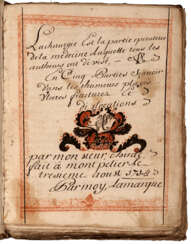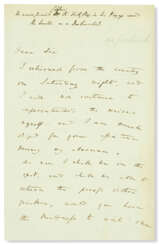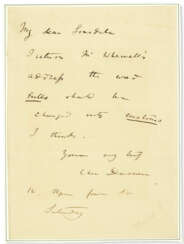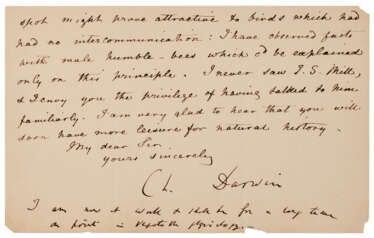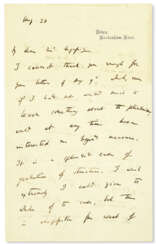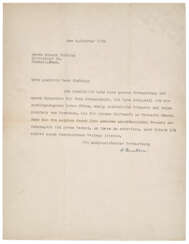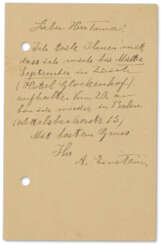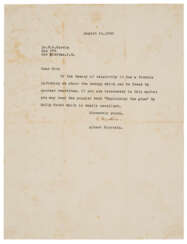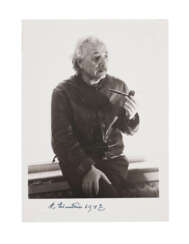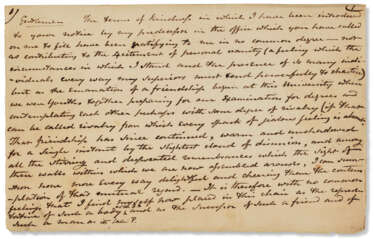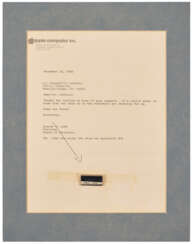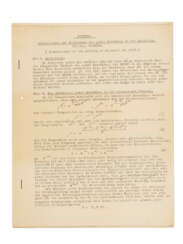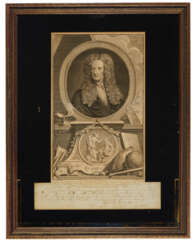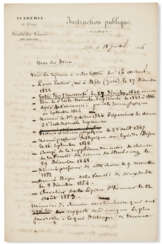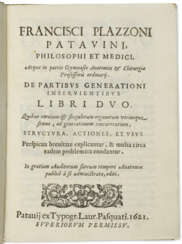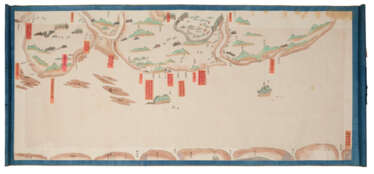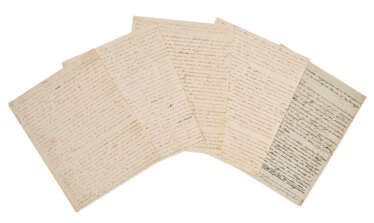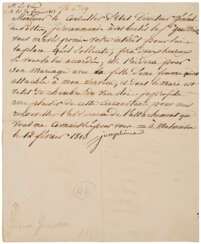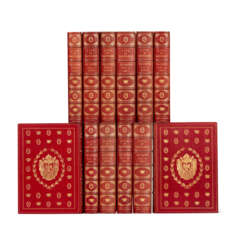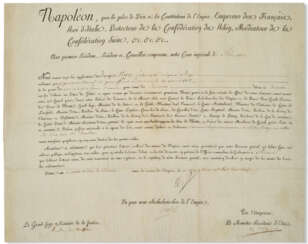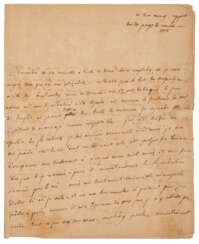
Letters, documents and manuscripts — Fine Printed Books and Manuscripts including Americana
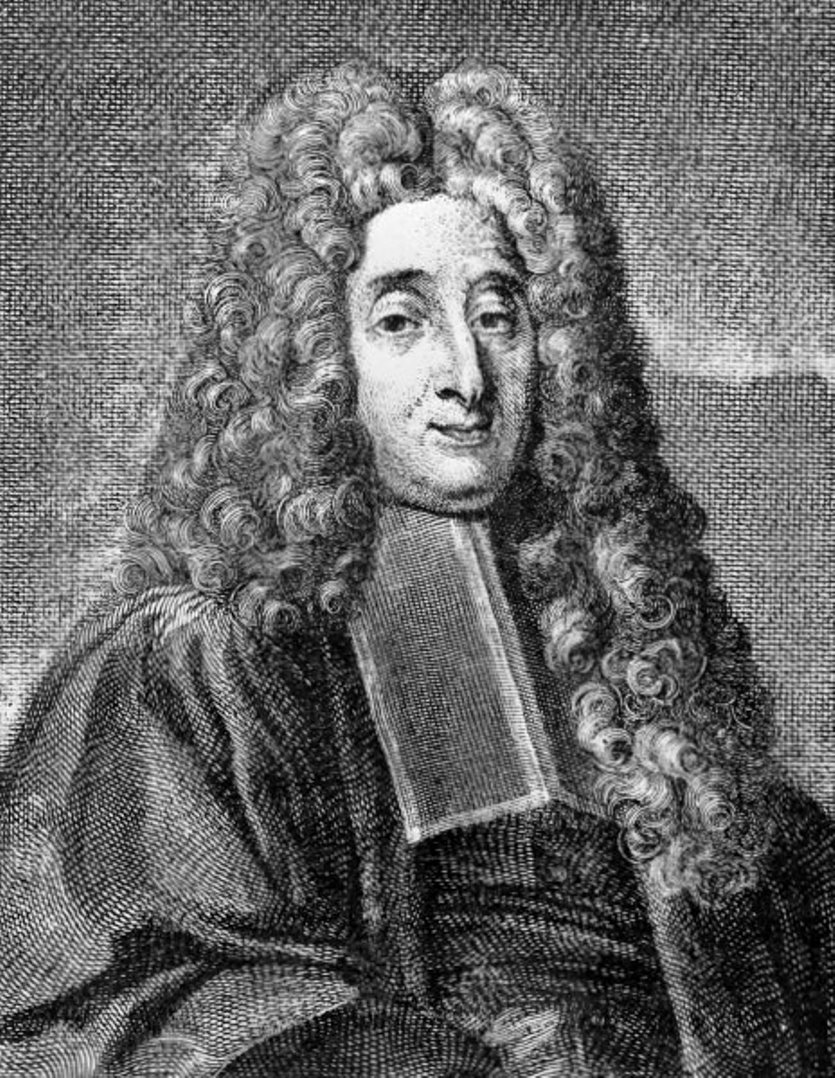
Pierre Chirac was a French physician and chief physician to Louis XV.
Chirac received his Doctor of Medicine degree from Montpellier in 1683, and three years later became professor of medicine. He was elected a member of the Academy of Sciences in 1716, became head of the Royal Garden of Medicinal Plants in 1718, and was appointed physician to Louis XV in 1731. In the 1690s Chirac selflessly and successfully engaged in the treatment of rampant at that time dysentery, yellow fever, smallpox.
Pierre Chirac was one of the leading physicians of his time; with an inquisitive mind, he was interested in several fields of medicine. In 1692, he wrote a significant treatise on cardiology.
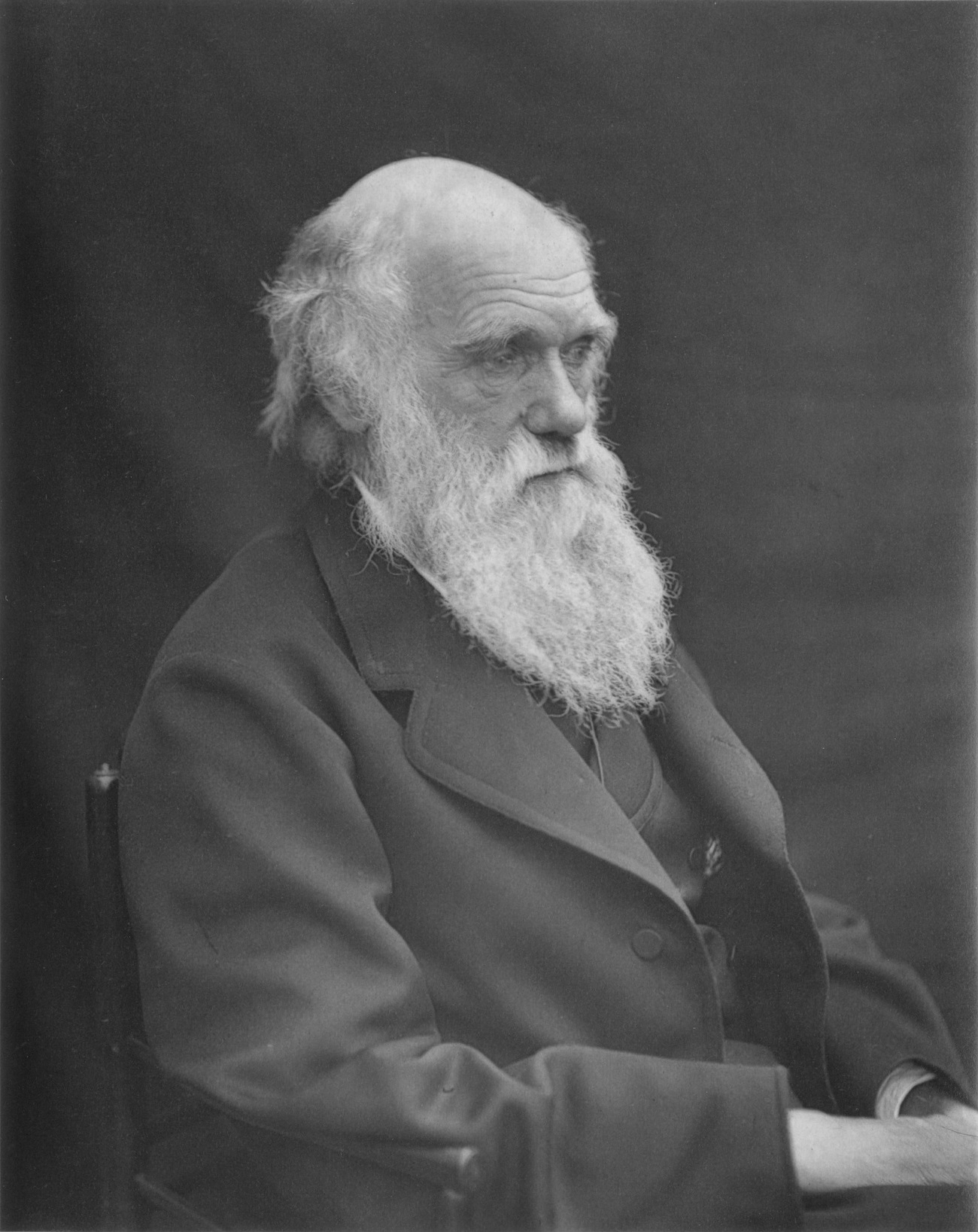
Charles Robert Darwin was an English naturalist, geologist, and biologist, widely known for contributing to the understanding of evolutionary biology. His proposition that all species of life have descended from a common ancestor is now generally accepted and considered a fundamental concept in science. In a joint publication with Alfred Russel Wallace, he introduced his scientific theory that this branching pattern of evolution resulted from a process that he called natural selection, in which the struggle for existence has a similar effect to the artificial selection involved in selective breeding. Darwin has been described as one of the most influential figures in human history, and he was honoured by burial in Westminster Abbey.

Charles Robert Darwin was an English naturalist, geologist, and biologist, widely known for contributing to the understanding of evolutionary biology. His proposition that all species of life have descended from a common ancestor is now generally accepted and considered a fundamental concept in science. In a joint publication with Alfred Russel Wallace, he introduced his scientific theory that this branching pattern of evolution resulted from a process that he called natural selection, in which the struggle for existence has a similar effect to the artificial selection involved in selective breeding. Darwin has been described as one of the most influential figures in human history, and he was honoured by burial in Westminster Abbey.

Charles Robert Darwin was an English naturalist, geologist, and biologist, widely known for contributing to the understanding of evolutionary biology. His proposition that all species of life have descended from a common ancestor is now generally accepted and considered a fundamental concept in science. In a joint publication with Alfred Russel Wallace, he introduced his scientific theory that this branching pattern of evolution resulted from a process that he called natural selection, in which the struggle for existence has a similar effect to the artificial selection involved in selective breeding. Darwin has been described as one of the most influential figures in human history, and he was honoured by burial in Westminster Abbey.

Charles Robert Darwin was an English naturalist, geologist, and biologist, widely known for contributing to the understanding of evolutionary biology. His proposition that all species of life have descended from a common ancestor is now generally accepted and considered a fundamental concept in science. In a joint publication with Alfred Russel Wallace, he introduced his scientific theory that this branching pattern of evolution resulted from a process that he called natural selection, in which the struggle for existence has a similar effect to the artificial selection involved in selective breeding. Darwin has been described as one of the most influential figures in human history, and he was honoured by burial in Westminster Abbey.

Albert Einstein was a German-born theoretical physicist, widely acknowledged to be one of the greatest and most influential physicists of all time. Einstein is best known for developing the theory of relativity, but he also made important contributions to the development of the theory of quantum mechanics. Relativity and quantum mechanics are together the two pillars of modern physics. His mass–energy equivalence formula E = mc2, which arises from relativity theory, has been dubbed "the world's most famous equation". His work is also known for its influence on the philosophy of science. He received the 1921 Nobel Prize in Physics "for his services to theoretical physics, and especially for his discovery of the law of the photoelectric effect", a pivotal step in the development of quantum theory. His intellectual achievements and originality resulted in "Einstein" becoming synonymous with "genius".

Albert Einstein was a German-born theoretical physicist, widely acknowledged to be one of the greatest and most influential physicists of all time. Einstein is best known for developing the theory of relativity, but he also made important contributions to the development of the theory of quantum mechanics. Relativity and quantum mechanics are together the two pillars of modern physics. His mass–energy equivalence formula E = mc2, which arises from relativity theory, has been dubbed "the world's most famous equation". His work is also known for its influence on the philosophy of science. He received the 1921 Nobel Prize in Physics "for his services to theoretical physics, and especially for his discovery of the law of the photoelectric effect", a pivotal step in the development of quantum theory. His intellectual achievements and originality resulted in "Einstein" becoming synonymous with "genius".

Albert Einstein was a German-born theoretical physicist, widely acknowledged to be one of the greatest and most influential physicists of all time. Einstein is best known for developing the theory of relativity, but he also made important contributions to the development of the theory of quantum mechanics. Relativity and quantum mechanics are together the two pillars of modern physics. His mass–energy equivalence formula E = mc2, which arises from relativity theory, has been dubbed "the world's most famous equation". His work is also known for its influence on the philosophy of science. He received the 1921 Nobel Prize in Physics "for his services to theoretical physics, and especially for his discovery of the law of the photoelectric effect", a pivotal step in the development of quantum theory. His intellectual achievements and originality resulted in "Einstein" becoming synonymous with "genius".

Albert Einstein was a German-born theoretical physicist, widely acknowledged to be one of the greatest and most influential physicists of all time. Einstein is best known for developing the theory of relativity, but he also made important contributions to the development of the theory of quantum mechanics. Relativity and quantum mechanics are together the two pillars of modern physics. His mass–energy equivalence formula E = mc2, which arises from relativity theory, has been dubbed "the world's most famous equation". His work is also known for its influence on the philosophy of science. He received the 1921 Nobel Prize in Physics "for his services to theoretical physics, and especially for his discovery of the law of the photoelectric effect", a pivotal step in the development of quantum theory. His intellectual achievements and originality resulted in "Einstein" becoming synonymous with "genius".
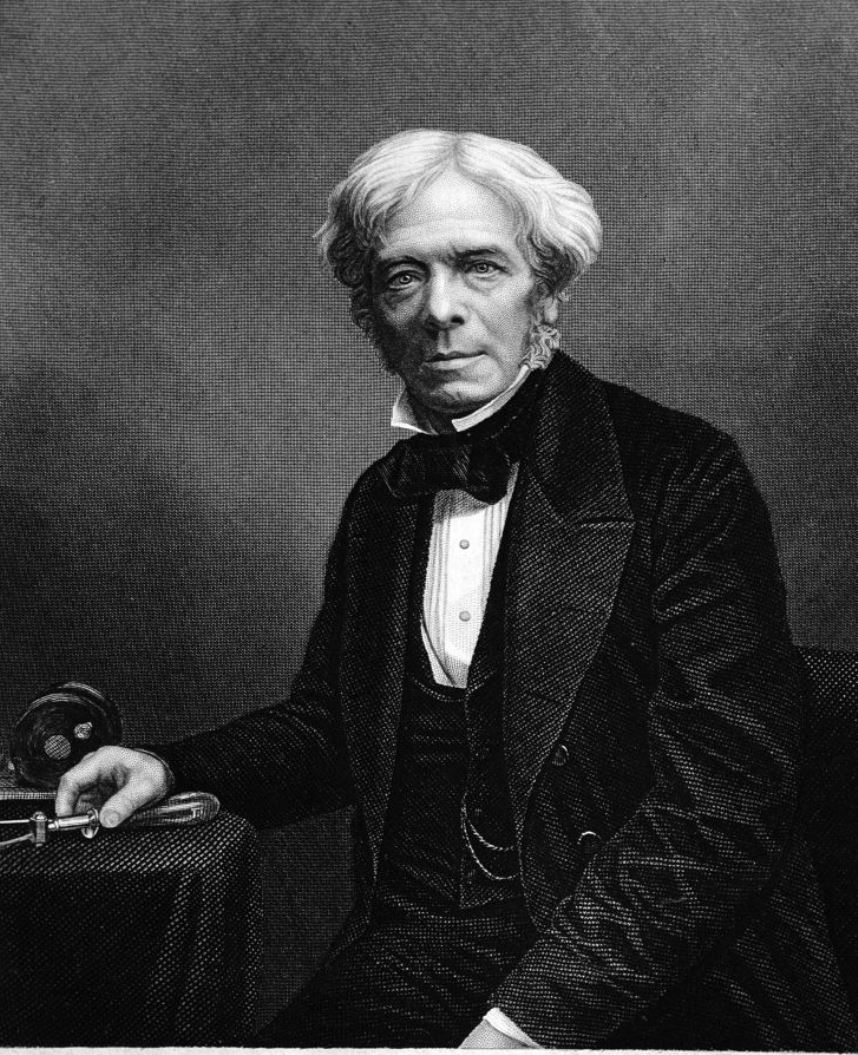
Michael Faraday was a British physicist and chemist, explorer and experimenter.
Faraday, because of his family's poverty, was unable to receive a formal education, but at the bookbinding shop in London where he worked, he read many books, including encyclopedias and textbooks on chemistry and physics. He persevered in self-education, attending hearings at the City Philosophical Society and later lectures by Sir Humphry Davy at the Royal Institution, who as a result took the able student on as an apprentice. In 1825 he replaced the seriously ill Davy in the management of the laboratory of the Royal Institution.
In 1833 Faraday was appointed to a research chair of chemistry created especially for him, where, among other achievements, the scientist liquefied various gases, including chlorine and carbon dioxide. His study of heating and lighting oils led to the discovery of benzene and other hydrocarbons, and he experimented extensively with various steel alloys and optical glasses. Faraday was an excellent experimentalist who presented his ideas in simple language. He is best known for his contributions to the understanding of electricity and electrochemistry. The concepts behind electromagnetic induction, diamagnetism, and electrolysis were some of his most important discoveries. His electromagnetic research formed the basis of the electromagnetic equations that James Clerk Maxwell developed in the 1850s and 1860s.
Between 1831 and 1855, Faraday read a series of 30 papers before the Royal Society, which were published in his three-volume Experimental Investigations in Electricity. His bibliography numbers some 500 printed articles. By 1844 he had been elected a member of some 70 scientific societies, including the St. Petersburg Academy of Sciences.
.jpeg)
Sir John Frederick William Herschel, 1st Baronet was a British astronomer and son of the Uranus discoverer Wilhelm Herschel. He is credited with the first double star and nebula catalogues of the southern starry sky, which he observed during a five-year stay near Cape Town.
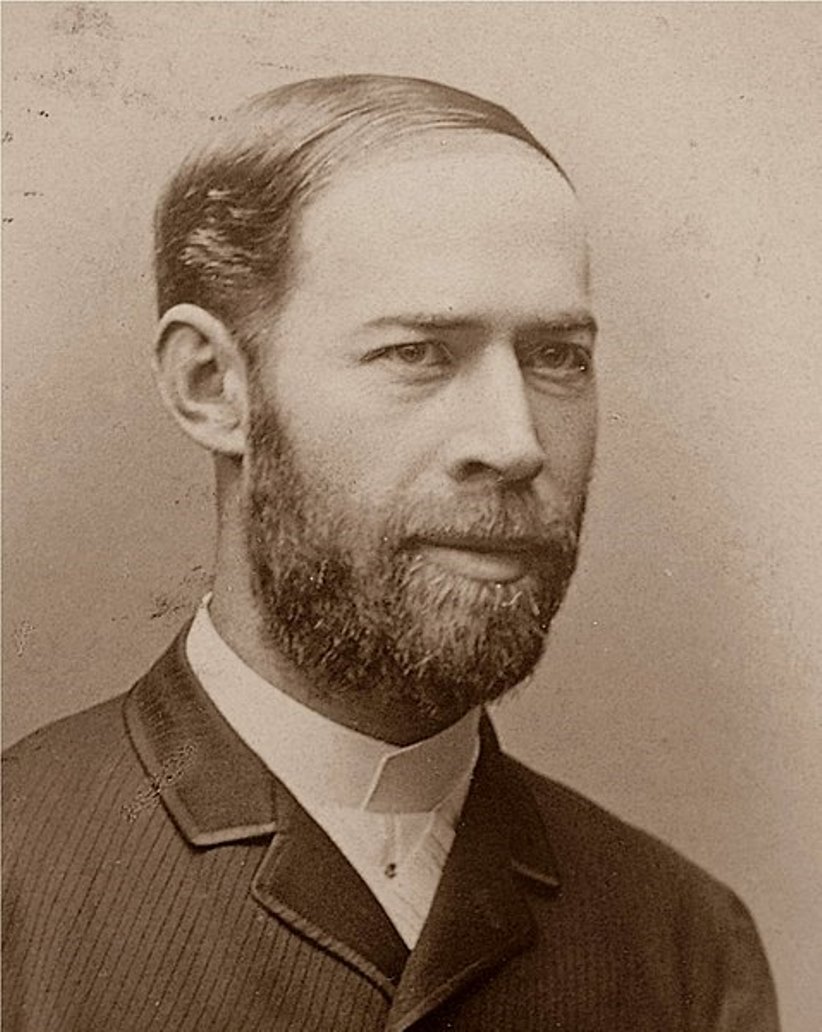
Heinrich Rudolf Hertz was a German physicist and inventor of radio waves.
Hertz graduated from the University of Berlin, studying under Hermann von Helmholtz and Gustav Kirchhoff, then was a professor of physics at the University of Karlsruhe, and from 1889 became a professor of physics at the University of Bonn.
A tireless experimenter, Hertz conducted various experiments with electric waves. Hertz reported his first discovery at the end of 1887 in a treatise "On the electromagnetic effects caused by electrical perturbations in insulators," which he sent to the Berlin Academy. For a time the waves he discovered were called Hertzian waves, but today they are known as radio waves. Hertz's discovery was a confirmation of James Clerk Maxwell's electromagnetic theory and paved the way for numerous advances in communication technology.
Hertz is also known for the discovery of the photoelectric effect, which occurred during his research on electromagnetic waves. Hertz was only 37 years old at the time of his death and many of his experiments and work remained unfinished, but his discovery of radio waves had a huge impact on the world in the 20th century, paving the way for the development of radio, television and radar.

Steve Jobs, full name Steven Paul Jobs, birth name Abdul Latif Jandali, is an American entrepreneur, inventor and industrial designer who pioneered the information technology era.
Jobs grew up in foster care, took a job at Atari Corporation as a video game designer in early 1974, then traveled to India, comprehending Zen Buddhism. At the same time, Jobs met former classmate Steven Wozniak (b. 1950), and together they developed one of the first personal computers and in 1976 founded Apple, which was the beginning of the personal computer revolution of the 1970s and 1980s.
In 1985, Jobs left Apple and founded NeXT, a company that developed a computer platform for universities and businesses. By 1997, Jobs had regained control of Apple by leading the corporation. Under his leadership, the company was saved from bankruptcy and began turning a profit a year later. Over the next decade, Jobs oversaw the development of the iMac, iTunes, iPod, iPhone, and iPad, as well as the development of the Apple Store, iTunes Store, App Store, and iBookstore. In 2011, Apple was recognized as the world's most valuable publicly traded company.
Steve Jobs passed away after a long illness at the age of 56. In July 2022, Jobs was posthumously awarded the Presidential Medal of Freedom, the highest U.S. civilian honor, for his invaluable contributions to the music, film, and computer industries.
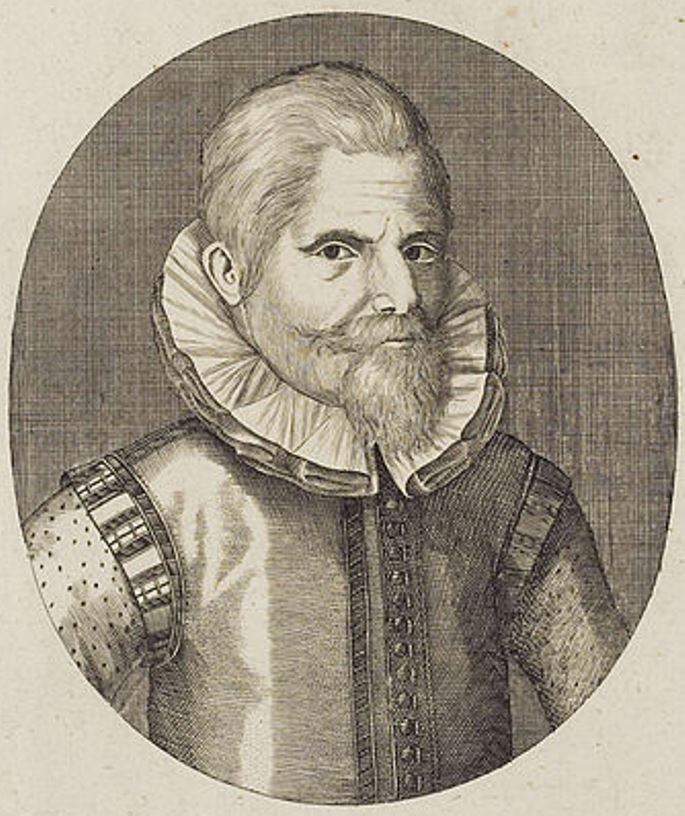
ohann Theodor de Bry (also Johann Dietrich de Bry) was a German publisher, engraver and draughtsman from the Calvinist de Bry family of artists.
Johann was the eldest son and apprentice of the Flemish painter and goldsmith Theodor de Bry (1528-1598). In 1598, Johann Theodor took over the family print shop and moved the business from Frankfurt to Oppenheim. In addition to many of his own works, he greatly added to the collection of "Portraits of Eminent Figures" begun by his father. De Bry specialized in richly illustrated scientific books.
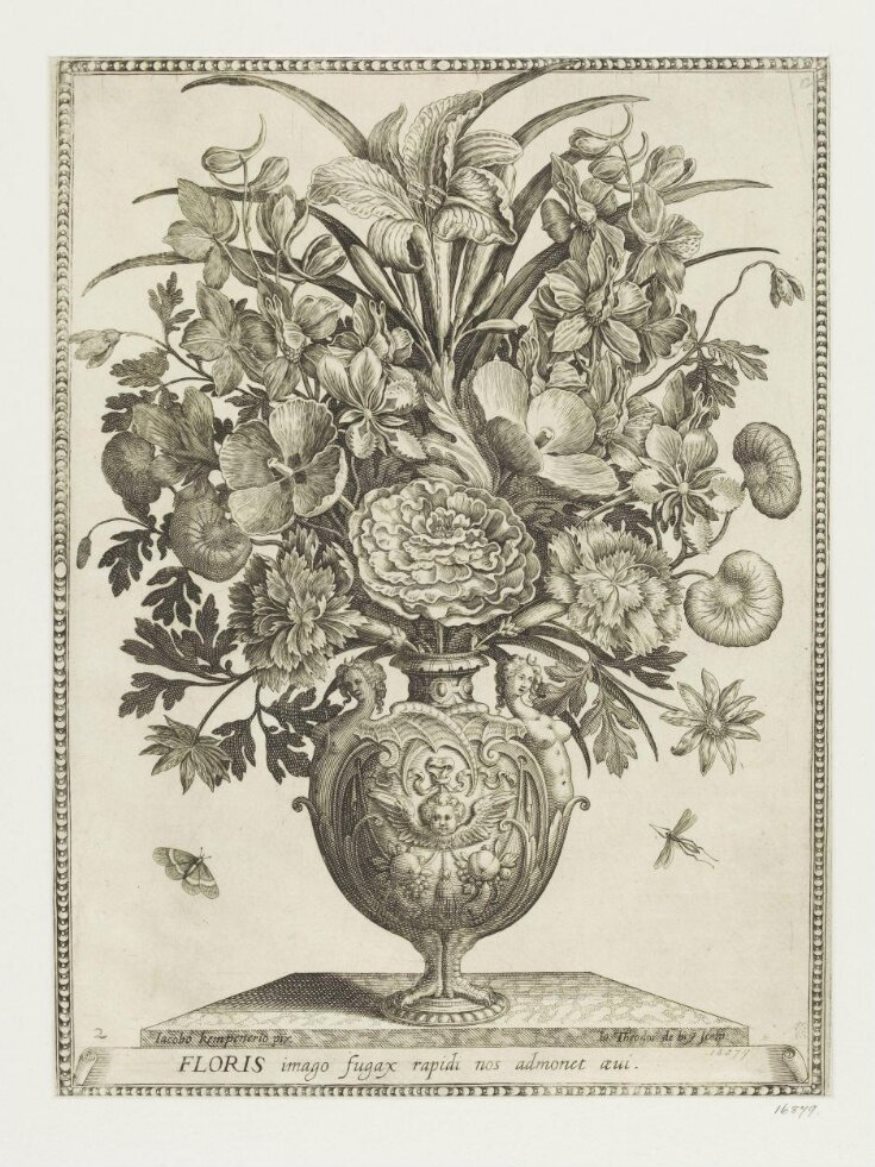
Jacob Kempener was a Flemish painter and engraver who lived and worked in Cologne in the 17th century.
He is known for Johann Theodor de Brie's engravings based on his still lifes.
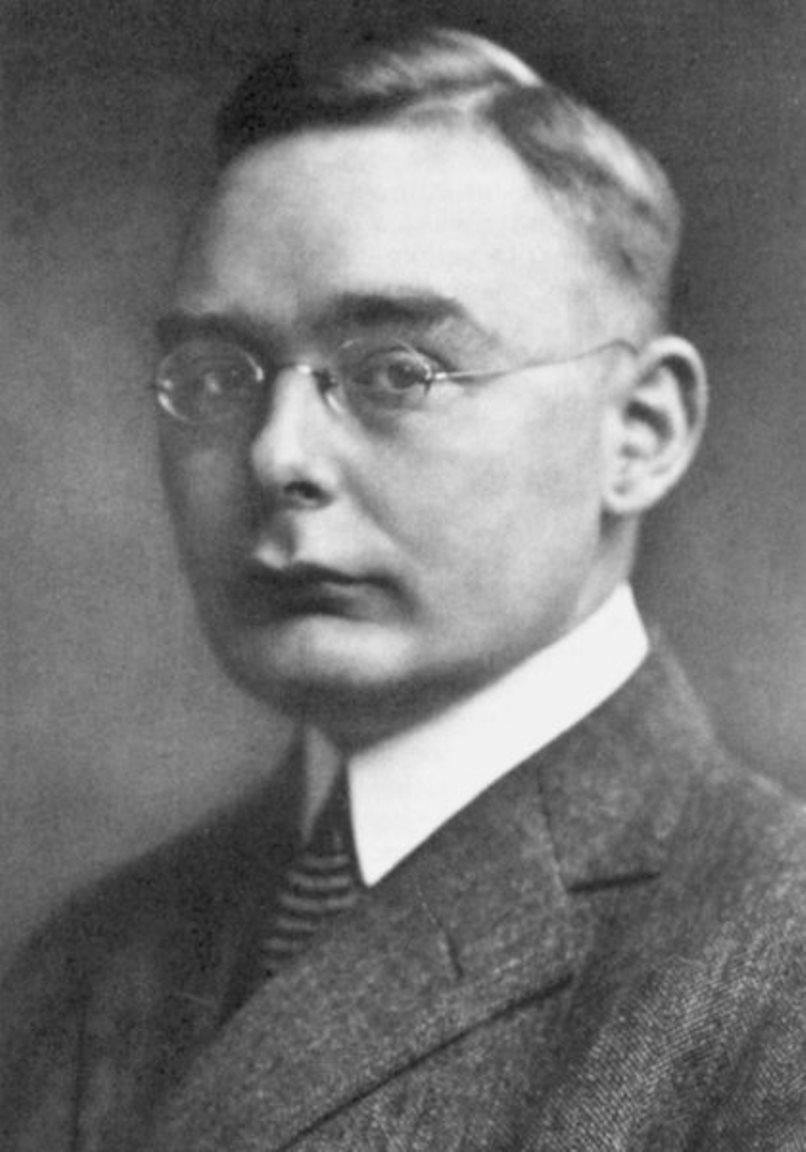
Hendrik Anthony Kramers was a Dutch theoretical physicist and a member of the Royal Netherlands Academy of Sciences.
Kramers studied mathematics and physics at Leiden University before being recruited in Copenhagen by future Nobel Prize-winning physicist Niels Bohr (1885-1962). He tried to understand how electromagnetic waves interact with matter and made important contributions to quantum mechanics and statistical physics. Under Bohr's supervision, Kramers prepared his dissertation.
In 1926, Kramers left Denmark and became a professor of theoretical physics at Utrecht University, and from 1931 he also worked at Delft University of Technology. After the end of World War II, the scientist was active in Europe and taught in the United States.
Kramers' scientific works are devoted to atomic physics, quantum mechanics, solid-state physics, low-temperature physics, physical optics, and the kinetic theory of gases. Together with Ralph de Laer Kronig, he derived important equations relating absorption to the dispersion of light. Kramers' research on X-rays led to the development of equations for determining the efficiency and intensity of X-ray production.
In the 1930s, Kramers worked as an editor of a literary magazine, wrote and translated poetry into Dutch, and was an expert on the works of Shakespeare.
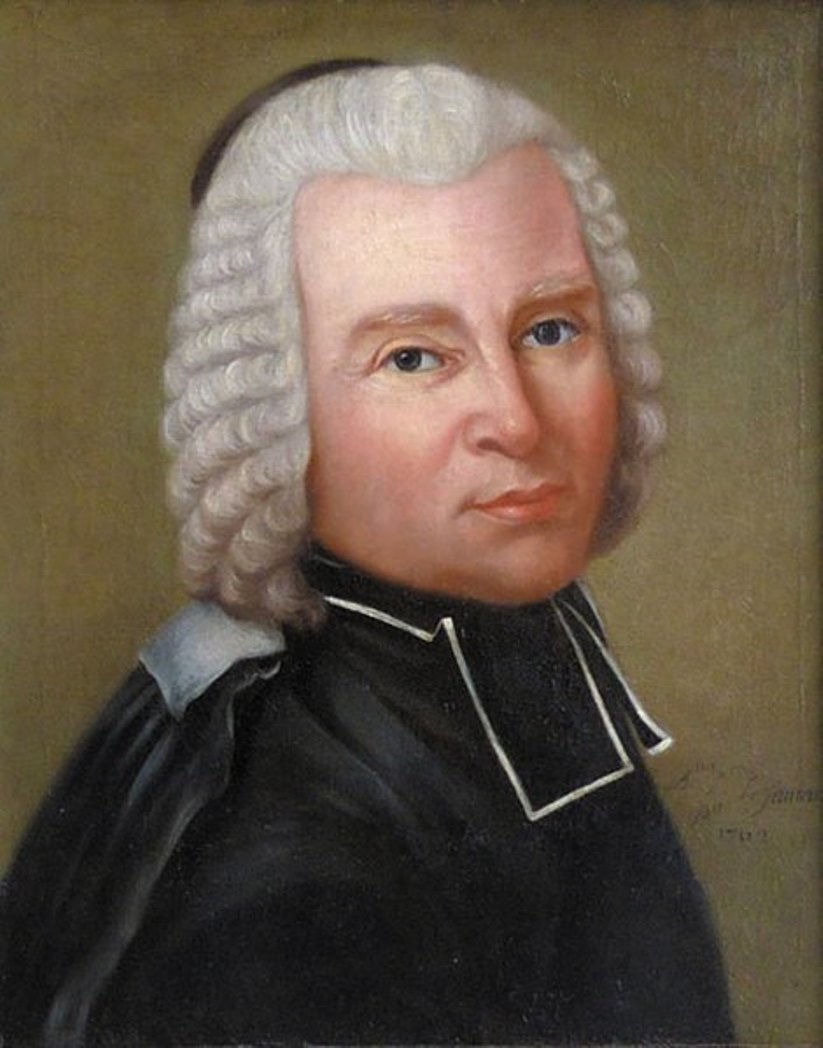
Nicolas-Louis De la Caille was a French astronomer, abbot and educator.
He studied philosophy and theology, became an abbot, but the craving for science overpowered everything, and he studied astronomy on his own. In 1736, la Caille received a place at the Paris Observatory, in 1739 was appointed professor of mathematics at Mazarini-College in Paris and built his own observatory, where he conducted astronomical observations. In 1741 Lacaille was admitted to the Académie des Sciences.
La Caille was an outstanding astronomer: he observed more than 10,000 stars in the Southern Hemisphere and named 14 of the 88 constellations. In 1752, he made an astronomical expedition to the Cape of Good Hope, where he built an observatory and conducted a huge series of observations, including the discovery and cataloging of 42 nebulae. These studies led to la Caille being called "the father of southern astronomy," and his observations from South Africa of the Moon, Venus, and Mars, combined with similar observations already made in the Northern Hemisphere, led to the calculation of more accurate values for the distances to these bodies.
On his return to Paris two years later, in 1754, he resumed his post and taught at the school of Mazarin, continuing his work at the observatory of the College of Mazarini. Among his pupils was the great chemist Antoine Lavoisier. La Caille was a foreign honorary member of the St. Petersburg Academy of Sciences and a member of the Royal Society of London. His Coelum Australe Stelliferum ("Star Catalog of the Southern Sky") was published in 1763.
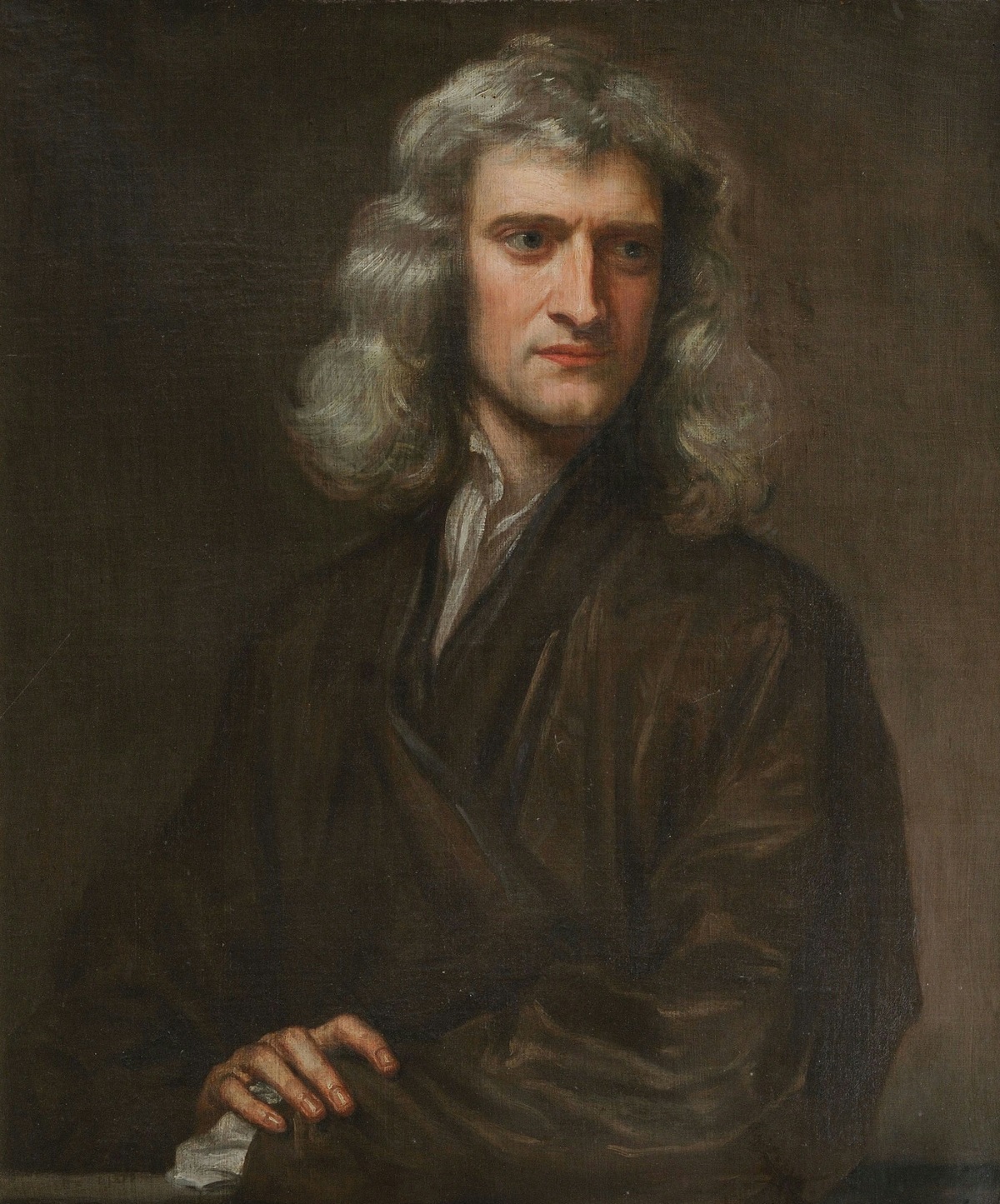
Isaac Newton was an English mathematician, physicist, astronomer, alchemist, theologian, and author (described in his time as a "natural philosopher"), widely recognised as one of the greatest mathematicians and physicists and among the most influential scientists of all time. He was a key figure in the philosophical revolution known as the Enlightenment. His book Philosophiæ Naturalis Principia Mathematica (Mathematical Principles of Natural Philosophy), first published in 1687, established classical mechanics. Newton also made seminal contributions to optics, and shares credit with German mathematician Gottfried Wilhelm Leibniz for developing infinitesimal calculus.
In the Principia, Newton formulated the laws of motion and universal gravitation that formed the dominant scientific viewpoint until it was superseded by the theory of relativity. Newton used his mathematical description of gravity to derive Kepler's laws of planetary motion, account for tides, the trajectories of comets, the precession of the equinoxes and other phenomena, eradicating doubt about the Solar System's heliocentricity. He demonstrated that the motion of objects on Earth and celestial bodies could be accounted for by the same principles. Newton's inference that the Earth is an oblate spheroid was later confirmed by the geodetic measurements of Maupertuis, La Condamine, and others, convincing most European scientists of the superiority of Newtonian mechanics over earlier systems.
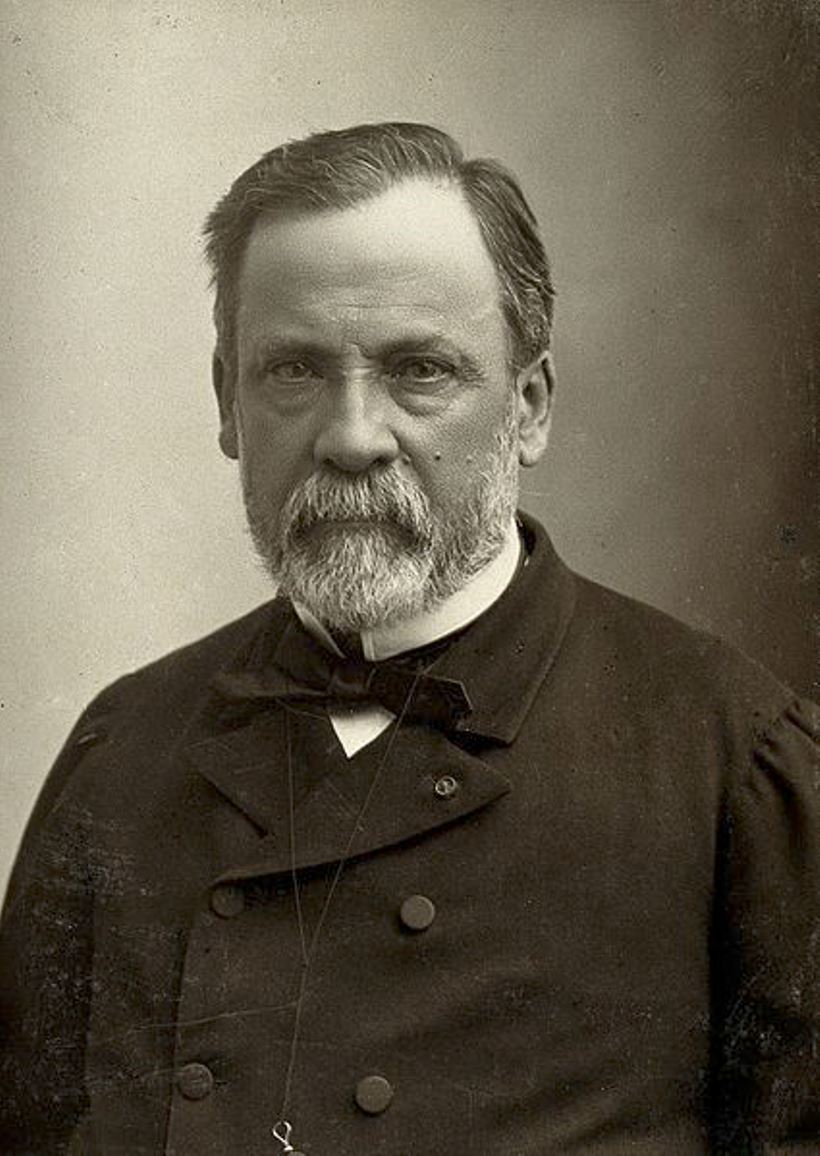
Louis Pasteur was a French chemist and the founder of microbiology and vaccination.
Pasteur received a bachelor of arts and sciences from the Royal College of Besançon and a doctorate from the École Normale in Paris, then spent several years as a researcher and teacher at the Lycée de Dijon. In 1848 he became professor of chemistry at the University of Strasbourg, and in the following year began to study the nature of wine fermentation, which began his revolutionary journey of most important scientific discoveries.
He invented a way to kill bacteria by boiling and then cooling the liquid, a process known today as pasteurization. Pasteur discovered the first vaccine in 1879 when he was exposed to a disease called chicken cholera. By accidentally exposing chickens to a weakened form of the culture, he demonstrated that they became resistant to the actual virus. Pasteur subsequently expanded his theory of germs and developed causes and vaccines against anthrax, cholera, tuberculosis, and smallpox, and the success of Pasteur's rabies vaccine in 1885 brought him worldwide fame.
Louis Pasteur's contribution to science, technology and medicine cannot be overemphasized. He pioneered the study of molecular asymmetry; discovered that microorganisms cause fermentation and disease; invented the process of pasteurization; saved the brewing, wine and silk industries in France; developed vaccines against the dreaded diseases anthrax and rabies, which saved millions of lives.
In 1873, Pasteur was elected an associate member of the Academy of Medicine, in 1882 - a member of the French Academy, and in 1888 in Paris was opened the Pasteur Institute. He was also awarded France's highest honor, the Legion of Honor.
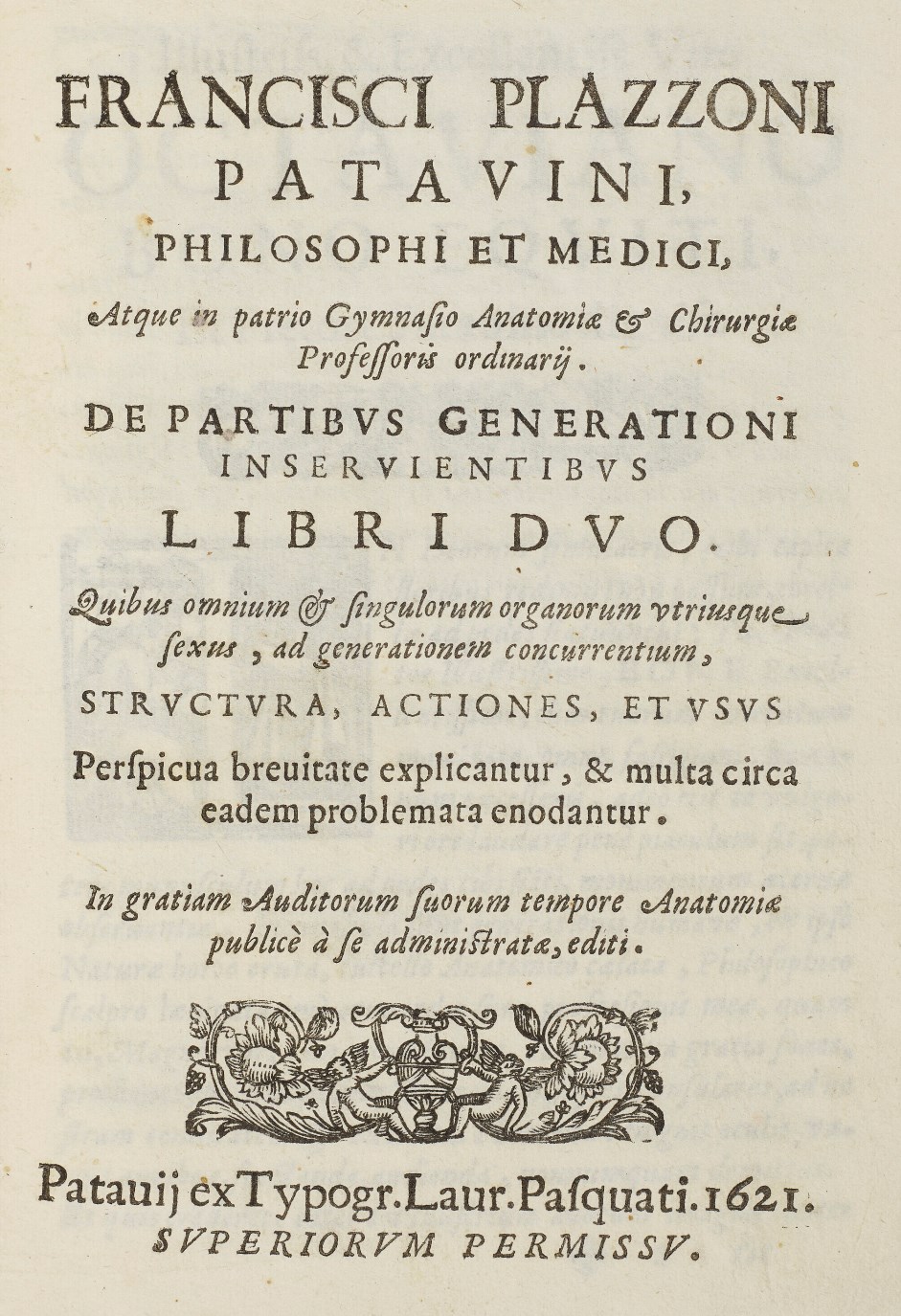
Francesco Plazzoni was an Italian physician and anatomist.
Plazzoni was a fellow student of Fabrizi and colleague of Spigellius, and taught in Padua. He is the author of the treatise De partibus generationi inservientibus libri duo (Padua, 1621). His text is based on Plazzoni's anatomical lectures in Padua and deals with the physiology of the penis, the clitoris, and sexual arousal.
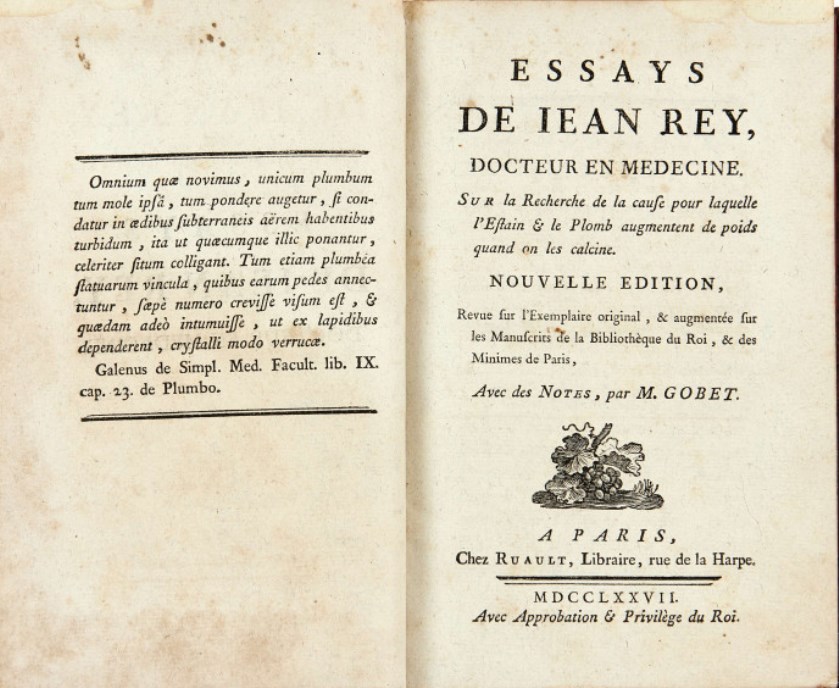
Jean Rey was a French chemist and physician.
Rey received a Master of Arts degree from the Academy of Montauban, then a doctorate from the University of Montpellier, and worked as a physician in his hometown of Le Bug. He was also engaged in chemical research, corresponded with R. Descartes, M. Mersenne and others.
Jean Rey was the first to express the idea of conservation of mass as applied to chemical reactions. While conducting experiments in his brother's forge, he discovered that the mass of lead and tin increases with calcination. The researcher explained this based on the assumption that air has mass and that lead and tin combine with air during calcination. In 1630 Rey published a treatise on this topic, "Experiments to find the reasons for the increase in the weight of tin and lead during calcination". As can be seen from the treatise, he realized that substances are made up of particles. His discovery of the weight of air also made possible the invention of the Torricelli barometer in 1643. Jean Rey also developed a device called the thermoscope, a precursor to the thermometer.
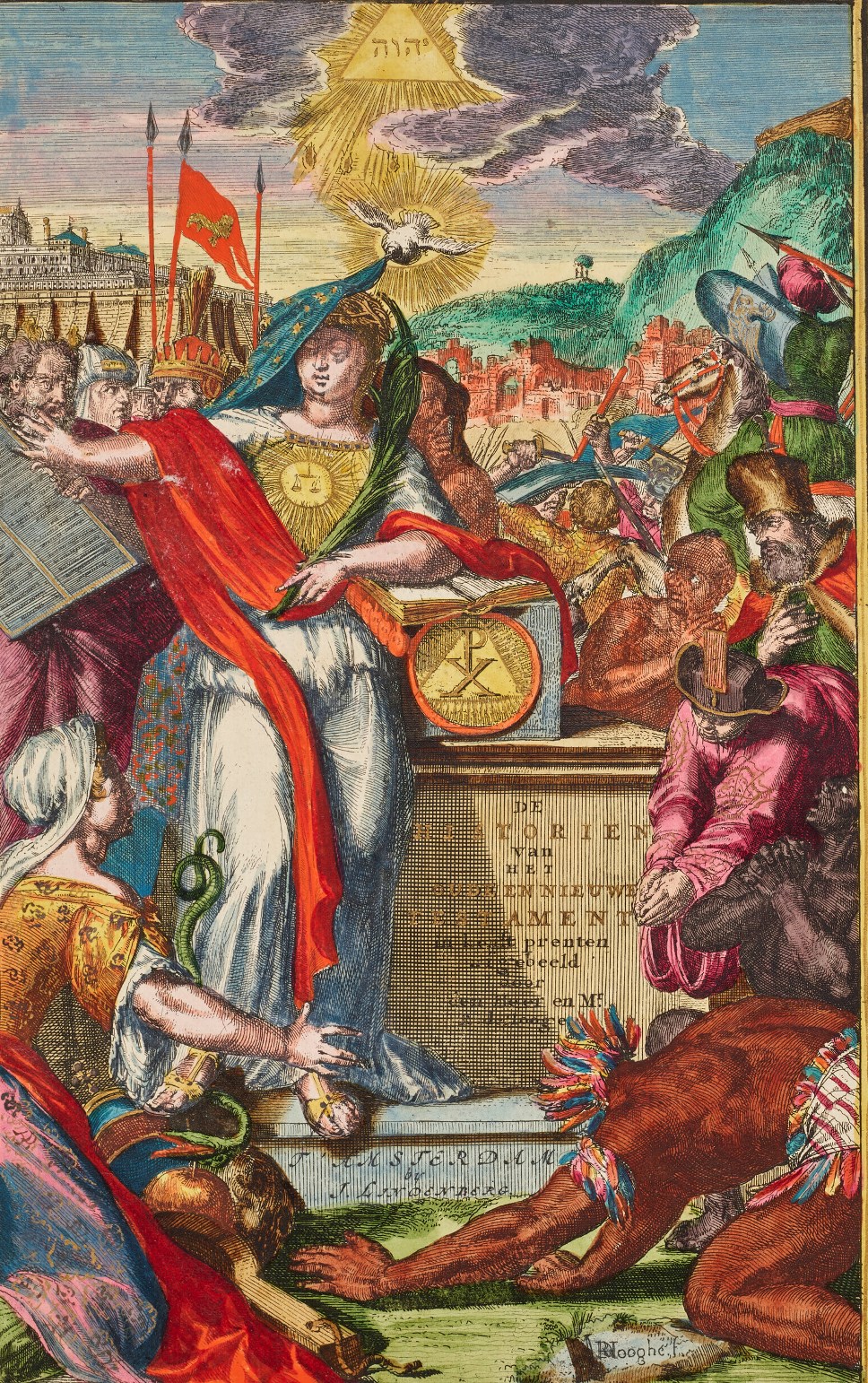
Arsène Lacarrière Latour, full name Géraud Calixte Jean Baptiste Arsène Lacarrière Latour, was a French-born American engineer and military officer, architect and surveyor, and writer.
He studied architecture and engineering at the Académie des Beaux-Arts in Paris and served briefly in the French Army Corps of Engineers. In 1805 Latour came to New York, where he worked first as a merchant, then as an architect and surveyor, and opened an architectural firm in New Orleans. In 1812. Latour became a U.S. citizen.
In 1814. Latour became Andrew Jackson's military engineer and made an important contribution to the American victory at the Battle of New Orleans. After the war ended, Latour published a book, Historical Memoirs of the War in West Florida and Louisiana, 1814-1815, which is still valued for its eye-witness view of the war.
In 1816. Latour traveled with Jean Lafitte on an expedition to survey and map the Southwest as an agent for Spain. From 1818 to 1834 he worked as an architect in Havana. His manuscripts include an extensive report describing Havana's thriving economy in 1815-1821, local agricultural production (sugar cane, coffee, tobacco), trade with Europe, the United States, and the colonies of South America; statistics; and a section on the city's possible future expansion and growth. Latour subsequently returned to France, where he died.
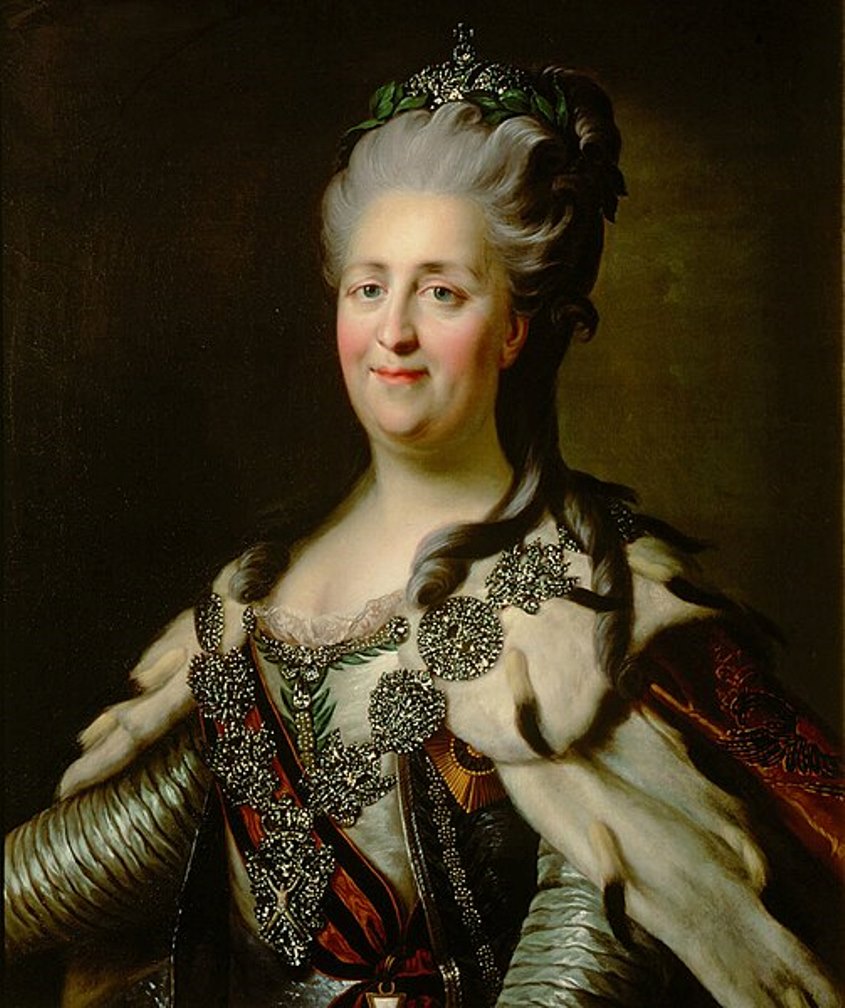
Ekaterina II, Ekaterina the Great; née Sophie Auguste Frederike von Anhalt-Zerbst-Dornburg, in Orthodoxy Ekaterina Alekseevna, was the Russian Empress and Sovereign of All Russia, mother of Emperor Paul I.
She was a niece of Swedish King Adolf Friedrich and a great-niece of Prussian King Frederick the Great. Sophie was a niece of the Swedish King Adolf Friedrich, and a great-niece of the Prussian King Frederick the Great. In 1744, at the invitation of Russian Empress Elizabeth Petrovna, she and her mother came to Russia, embraced Orthodoxy and was baptized with the name Ekaterina Alekseevna, and in 1745 married Grand Duke Peter Fyodorovich, the future Emperor Peter III. Immediately after arriving in Russia, Ekaterina II began to study the Russian language, history, and Russian traditions. She also read the works of the French enlighteners and works on philosophy, jurisprudence and economics, becoming a supporter of the ideas of the Enlightenment.
After the accession to the throne of Peter III, Ekaterina's relations with her husband deteriorated. Because of the threat of arrest and possible expulsion, Ekaterina decided to participate in the coup d'état, relying on the support of the Orlov brothers, Counts N. Panin and K. Razumovsky. On the night of June 28, 1762 Catherine secretly arrived in St. Petersburg and in the barracks of the Izmailovsky Regiment was proclaimed autocratic empress.
In the first years of her reign, Ekaterina II reformed the Senate, secularized church lands, which replenished the state treasury and alleviated the situation of a million peasants, abolished hetmanism in Ukraine, invited foreigners to Russia for the development of the Volga and Black Sea region. The Empress carried out important transformations in the military, social and financial spheres.
During her reign, Ekaterina II conducted two successful Russian-Turkish wars in 1768-1774 and 1787-1791, as a result of which Russia finally gained a foothold on the Black Sea. Having led an alliance with Austria and Prussia, Ekaterina participated in three partitions of Poland. In 1795, the empress issued a manifesto on the annexation of Courland to the Russian Empire. At the end of the 1780s, simultaneously with the Russo-Turkish war, the war with Sweden began, and in 1790 a peace treaty was signed, ending the Russo-Swedish war. In 1792 the Peace of Iasi was concluded, which consolidated Russia's influence in Bessarabia and Transcaucasia, as well as the annexation of Crimea.
Under the rule of Empress Ekaterina the Great, a whole pleiad of outstanding statesmen, military leaders, writers and artists appeared. Among them are Adjutant General I.I. Shuvalov, Generalissimo A.V. Suvorov, Field Marshal General G.A. Potemkin; enlightener, book publisher N.I. Novikov; historian, archaeologist, artist, writer, collector A.N. Olenin, President of the Russian Academy E.R. Dashkova.
Ekaterina II was buried in the vault of the Peter and Paul Cathedral. After 77 years in St. Petersburg on Alexandrinskaya Square was inaugurated a monument to the great empress. In the history of Russia she rightfully entered first of all as an enlightener.
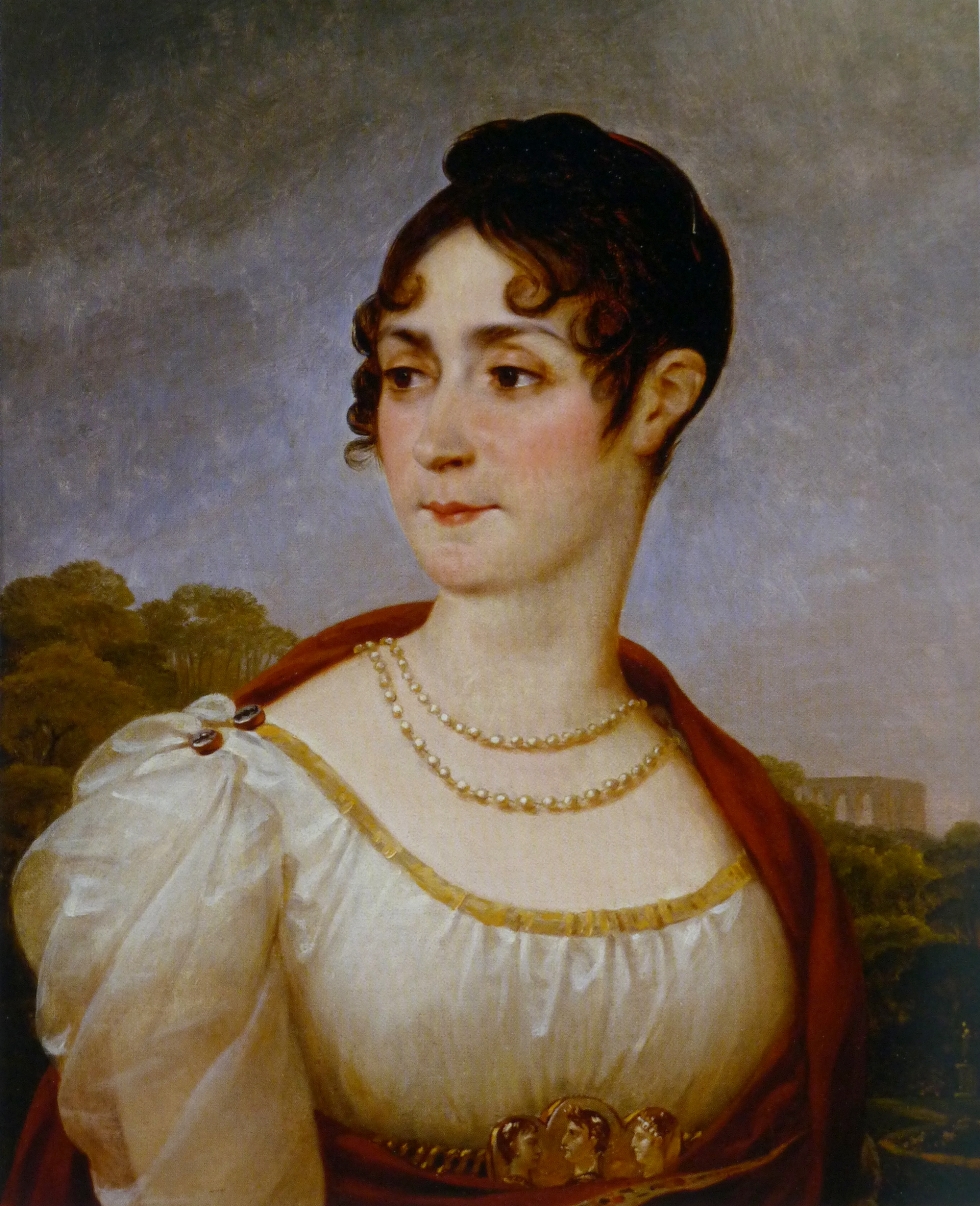
Joséphine de Beauharnais, born Marie Josèphe Rose Tascher de La Pagerie, was Empress of France from 1804 to 1809, the first wife of Napoleon I.
At the age of 16, Rose came to France to marry a young officer, Alexandre de Beauharnais. However, after the birth of their two children, the couple separated but maintained a relationship. During the French Revolution, her husband, who served in the revolutionary army, was guillotined in June 1794. Rose herself was imprisoned, but after the coup d'état of July 27, which ended the terror, she was released.
She was soon introduced to General Napoleon Bonaparte, and although she was a poor widow with two children, he was charmed and married her in a civil marriage in 1796. He and began to call her Josephine. She was with him all the way from general to First Consul and in May 1804 to Emperor of France. However, Josephine failed to produce an heir, prompting Napoleon, in the interest of the country, to divorce her in 1809. Retaining the title of empress and queen, she went to live at Château Malmaison near Paris and then at her Château of Navarre in Normandy, where she died in 1814, a few weeks after Napoleon's abdication.
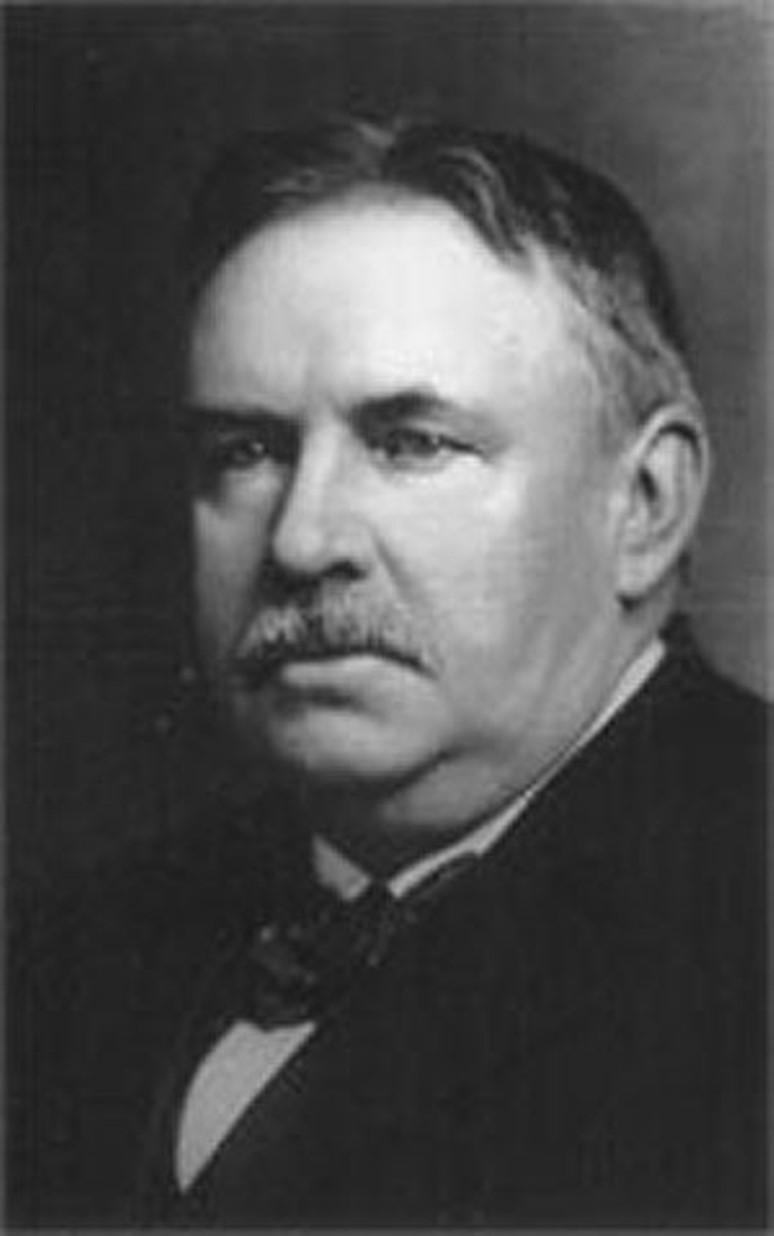
William Milligan Sloane is an American educator and historian.
Sloane graduated from Columbia College, then taught history and chaired departments at Princeton and Columbia. He subsequently earned a doctorate from the University of Leipzig. William Sloane wrote several books on European history. The best known of these was Napoleon Bonaparte (4 vols., 1895-97), a monumental work of biographical and historical literature.
He later served as president of the American Academy of Arts and Letters (1920-28), the American Historical Association, and the National Institute of Arts and Letters. Sloane was also an officer of the French Legion of Honor and a Commander of the Order of the Polaris of Sweden. William Sloane was also a founding member of the IOC and served on its board from 1894 to 1924.
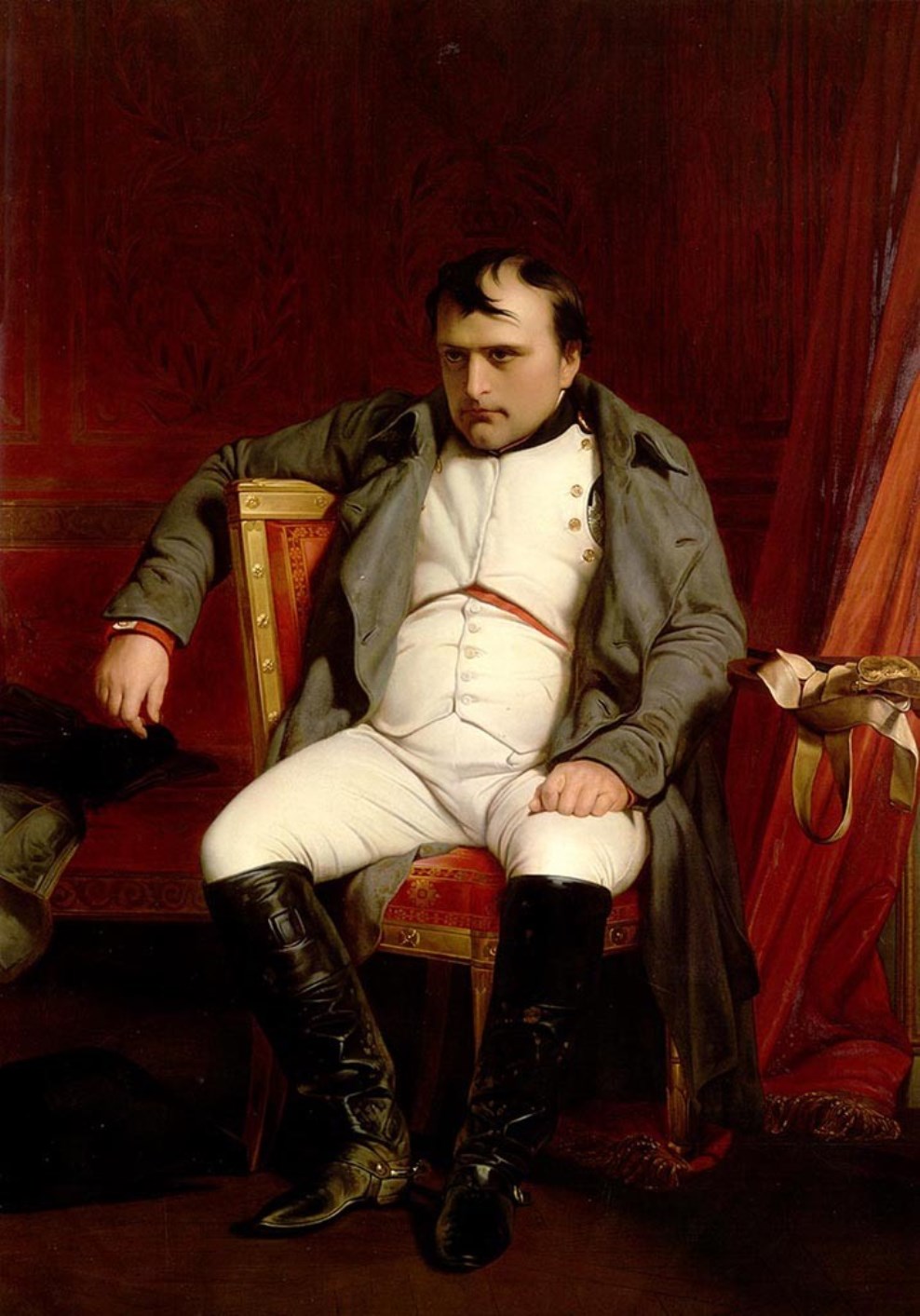
Napoleon I Bonaparte was a French statesman and military leader, Emperor of France (1804-1815).
Napoleon was born in the family of an ignorant Corsican nobleman, graduated from the Brienne military school, then the Paris military school. In 1785 he began military service in the rank of junior lieutenant of artillery in the Royal Army. From the first days of the Great French Revolution of 1789-1799 Bonaparte joined the political struggle on the island of Corsica, in 1792 in Valence joined the Jacobin Club and actively participated in all the turbulent political and military events.
In November 1799 Napoleon was at the head of a coup d'état: the government of the Directory was deposed, and the French Republic was headed by three consuls, the first of whom was Napoleon. In June 1804 Bonaparte was proclaimed Emperor Napoleon I of France, and in December a lavish coronation ceremony took place. After Italy recognized him as its king, in March 1805 he was also crowned in Milan.
With his rise to power, France entered a period of almost continuous warfare. Napoleon greatly expanded the territory of the empire, made most of the states of Western and Central Europe dependent on France. His brothers became kings: Joseph in Naples, Louis in Holland, and Jerome in Westphalia. In 1812, Napoleon made a campaign against Russia and even reached Moscow, but the Russian troops under the leadership of commander M.I. Kutuzov with the active support of all the people completely defeated the "invincible army". This military campaign was the beginning of the collapse of Napoleon's empire. The entry of the anti-French coalition troops into Paris in March 1814 forced Napoleon I to abdicate (April 6, 1814).
Napoleon retained the title of Emperor and was given possession of the island of Elba in the Mediterranean Sea. However, in March 1815, the deposed emperor at the head of a small detachment suddenly landed in the south of France and three weeks later, without a single shot entered Paris. But the emperor failed to live up to the hopes of the people of France, plus his defeat at the Battle of Waterloo all led to his second abdication. As a result, Napoleon Bonaparte was exiled to the island of St. Helena in the Atlantic Ocean, where he died on May 5, 1821.

Napoleon I Bonaparte was a French statesman and military leader, Emperor of France (1804-1815).
Napoleon was born in the family of an ignorant Corsican nobleman, graduated from the Brienne military school, then the Paris military school. In 1785 he began military service in the rank of junior lieutenant of artillery in the Royal Army. From the first days of the Great French Revolution of 1789-1799 Bonaparte joined the political struggle on the island of Corsica, in 1792 in Valence joined the Jacobin Club and actively participated in all the turbulent political and military events.
In November 1799 Napoleon was at the head of a coup d'état: the government of the Directory was deposed, and the French Republic was headed by three consuls, the first of whom was Napoleon. In June 1804 Bonaparte was proclaimed Emperor Napoleon I of France, and in December a lavish coronation ceremony took place. After Italy recognized him as its king, in March 1805 he was also crowned in Milan.
With his rise to power, France entered a period of almost continuous warfare. Napoleon greatly expanded the territory of the empire, made most of the states of Western and Central Europe dependent on France. His brothers became kings: Joseph in Naples, Louis in Holland, and Jerome in Westphalia. In 1812, Napoleon made a campaign against Russia and even reached Moscow, but the Russian troops under the leadership of commander M.I. Kutuzov with the active support of all the people completely defeated the "invincible army". This military campaign was the beginning of the collapse of Napoleon's empire. The entry of the anti-French coalition troops into Paris in March 1814 forced Napoleon I to abdicate (April 6, 1814).
Napoleon retained the title of Emperor and was given possession of the island of Elba in the Mediterranean Sea. However, in March 1815, the deposed emperor at the head of a small detachment suddenly landed in the south of France and three weeks later, without a single shot entered Paris. But the emperor failed to live up to the hopes of the people of France, plus his defeat at the Battle of Waterloo all led to his second abdication. As a result, Napoleon Bonaparte was exiled to the island of St. Helena in the Atlantic Ocean, where he died on May 5, 1821.

Joséphine de Beauharnais, born Marie Josèphe Rose Tascher de La Pagerie, was Empress of France from 1804 to 1809, the first wife of Napoleon I.
At the age of 16, Rose came to France to marry a young officer, Alexandre de Beauharnais. However, after the birth of their two children, the couple separated but maintained a relationship. During the French Revolution, her husband, who served in the revolutionary army, was guillotined in June 1794. Rose herself was imprisoned, but after the coup d'état of July 27, which ended the terror, she was released.
She was soon introduced to General Napoleon Bonaparte, and although she was a poor widow with two children, he was charmed and married her in a civil marriage in 1796. He and began to call her Josephine. She was with him all the way from general to First Consul and in May 1804 to Emperor of France. However, Josephine failed to produce an heir, prompting Napoleon, in the interest of the country, to divorce her in 1809. Retaining the title of empress and queen, she went to live at Château Malmaison near Paris and then at her Château of Navarre in Normandy, where she died in 1814, a few weeks after Napoleon's abdication.
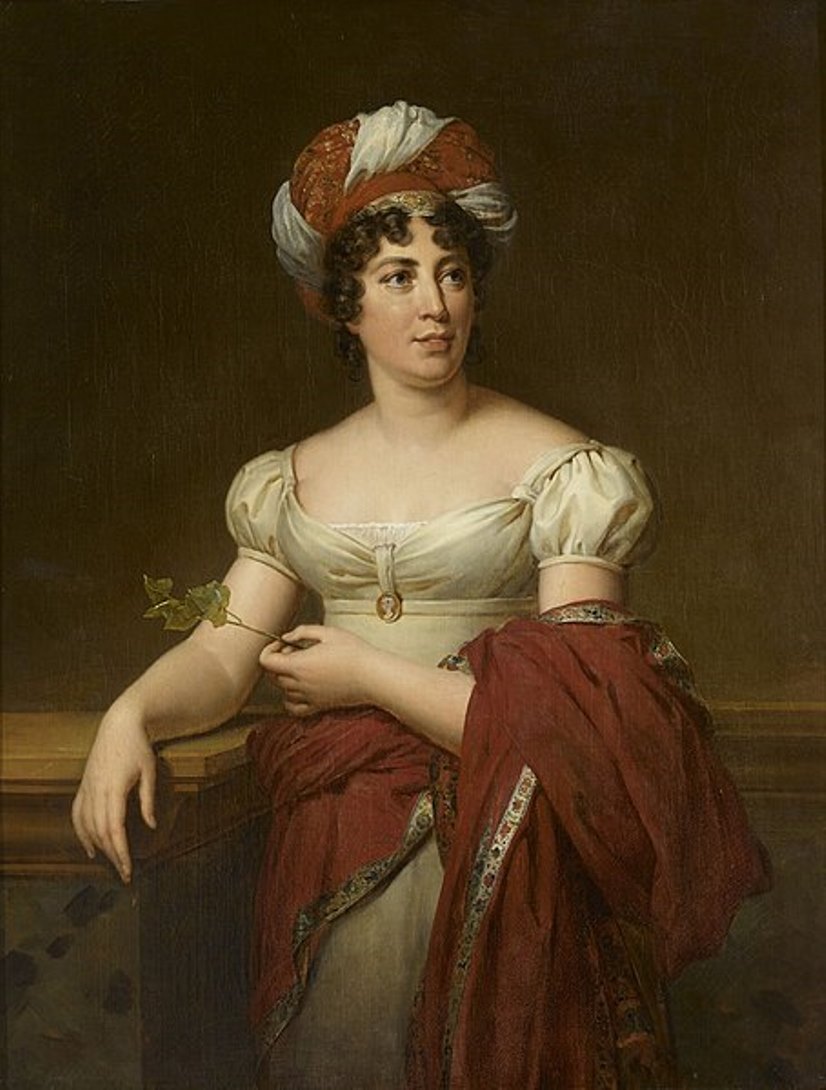
Anne-Louise-Germaine Necker, Baroness of Staël-Holstein, known as Madame de Staël, was a French writer, literary theorist, and publicist.
She was born into a Swiss family where her father was a banker and then finance minister to King Louis XVI, and her mother ran a brilliant literary and political salon in Paris where Voltaire, Diderot, and Hume frequented. Young Necker received a brilliant education, she absorbed the intellectual environment with great curiosity, becoming a witty and well-read conversationalist.
In 1786, she married the Swedish ambassador to Paris, Baron Eric de Staël-Holstein. It was a marriage of convenience, which ended in 1797 formal divorce.
Madame de Staël became known not only for her stunning and versatile works, but also for her enormous influence on the intellectual climate of that 19th century. During her lifetime she was known as a novelist, but she became much more famous as a political philosopher, literary critic, and theorist of Romanticism. Madame de Staël was an implacable opponent of Napoleon I and traveled around Europe for a decade during his reign from 1803. In 1810, the writer published one of her most famous and influential works, On Germany. She returned to Paris in 1814, after the fall of Napoleon, and wrote "Reflections on the Principal Events of the French Revolution."
In her travels, Madame de Staël met many politicians, artists and writers and was known for her cosmopolitanism and feminism. Madame de Staël epitomized the European culture of her time, combining ideas from neoclassicism to romanticism in her glittering salon for leading intellectuals.
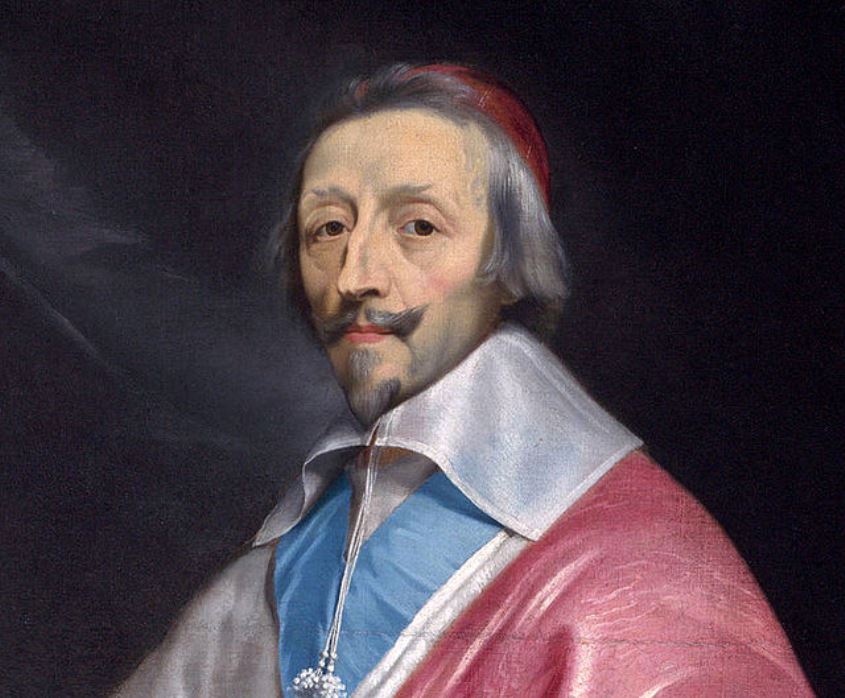
Armand-Jean du Plessis, duc de Richelieu, also known as Cardinal Richelieu or the Red Cardinal (French: l'Éminence rouge) was a Roman Catholic cardinal, aristocrat and statesman of France.
Armand Jean's father, François du Plessis, Signor de Richelieu, was the grand proclaimer (chief magistrate) of Henry III, but left his family devastated at his death. At the age of 22, Armand was ordained a priest and began to build a career. Thanks to his intellectual talents, he was soon appointed chaplain to the new Queen Anne of Austria, and in 1616 he was appointed Secretary of State for War and Foreign Affairs. Further events and a palace coup led to his exile, but he returned to Paris five years later.
The Duc de Richelieu became a cardinal in 1622, and from 1624 until his death in 1642 he was chief minister to King Louis XIII of France. His main goals were to establish royal absolutism in France and to end the Spanish-Habsburg hegemony in Europe. He made significant strides in reforming France, especially in terms of the administrative structure of the government.
The intrigues of his opponents accompanied the Duc de Richelieu throughout his political life. In the last years of his life he found himself involved in religious conflicts, in opposition to the pope in a struggle with the French church over the distribution of revenues intended to finance the war.
Richelieu possessed outstanding intellectual ability, willpower, and industriousness. He directed his own wealth to patronizing the arts and the University of Paris; he established the French Academy. Richelieu was also a talented playwright and musician.
